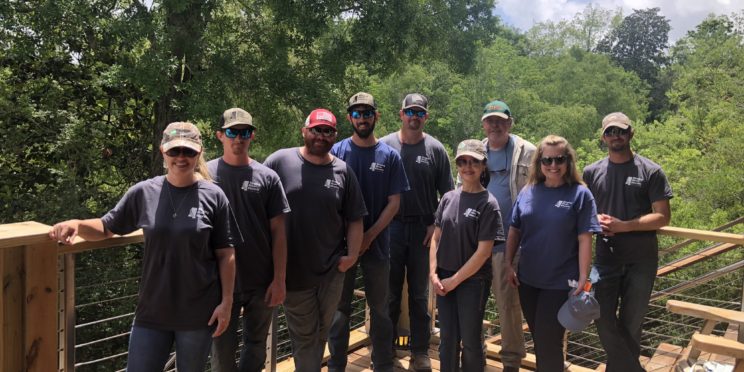Singing River Electric employees recently spent a day clearing invasive vegetation—a needed step in turning Moss Point’s Sawmill Landing into the ‘Gateway to the River City.’ Planning began in 2017 to turn a prime piece of riverfront property in Moss Point into a welcoming view for travelers.
Once covered in overgrown shrubs and vines, the property at the corner of Dantzler and Main Streets now highlights 100-year-old moss-draped oaks and a clear river view. Through a partnership between the City of Moss Point and the Pascagoula River Audubon Center (PRAC), the area is slated to become a nature-based tourism area.
“We are still working to rid the area of invasive species like Chinese tallow (also known as popcorn trees), Lantana, Sesbania, Wisteria, and Camphor,” explains PRAC volunteer David Minkler, an ISA-certified arborist leading this project. “I am so thankful for the volunteers at Singing River Electric. We are making good progress in the removal of non-native plants, but it’s continuous hard work. You guys have done a tremendous job here.”
Invasive plants can quickly overtake native vegetation, damaging wildlife habitats and destroying nature’s balance. Removing the invasive species allows for native plants like wax myrtle, yaupon holly, black cherry trees, Eastern red cedar trees, and live oaks to flourish.
Sawmill Landing was named to honor and remember the thriving sawmill industry that was once located along the Moss Point riverfront.
“Helping restore this native habitat area in Moss Point allows our employees to give back to the community and embrace the spirit of service,” said SRE General Manager and CEO Brian Hughey, CEO, Singing River Electric.
Employee volunteers include Brayden Bush, Stephanie Chisholm, Jeremy Evans, Lorri Freeman, Dustin Green, Nick Greer, Codey Holliman, Angela Rucker, and Carolyn Warrick.
Singing River Electric has an 84-year heritage of providing safe, reliable and affordable electricity to our local communities where we call home. SRE serves more than 77,500 meters across 7,618 miles of power lines in seven counties in Mississippi (Jackson, George, Greene, Perry, Stone, Wayne and Harrison) and two counties in Alabama (Mobile and Washington). The electric distribution cooperative works with Cooperative Energy to provide its members a diverse mix of generation resources including five small-scale solar sites locally and a 540-acre solar site in Lamar County. For more information, follow our conversations on Facebook, Twitter and Instagram.


